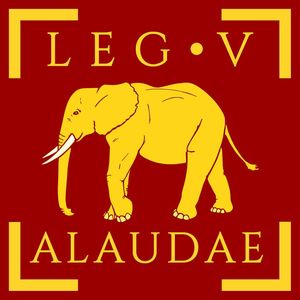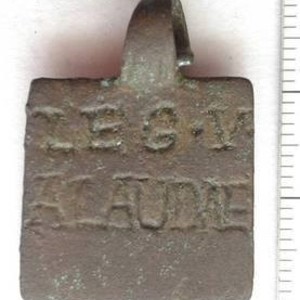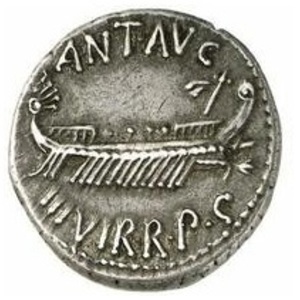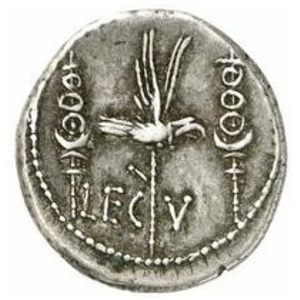Roman Legion - Legio V Alaudae
Legio V Alaudae (Fifth Legion of the Larks) was a Roman legion formed by Gaius Julius Caesar during the Republic.
Dates of existence: around 52 BC. Existed until 70 or 87 AD.
Symbol: Elephant. Despite the legion being called "the larks," its symbol was an elephant. This is due to the reward for military merits displayed by the legion in 49 BC during Caesar's African campaign, where it successfully fought against the war elephants of the Numidian King Juba I.
Battle Path
- The Legion was created Gaius Julius Caesar, not of Roman citizens, but of Gauls in 52 BC.
- Until 51 or 50 BC, when the Senate recognized the creation of this legion, Caesar maintained it at his own expense.
- The legion began its combat path by participating in the Gallic War (58-50 BC), where it took part in the Battle of Alesia (modern-day Alise-Sainte-Reine, France) in October 52 BC.
- In the Civil War (49-45 BC) that followed the Gallic War between Caesar and Pompey, the legion sided with Caesar. It participated in the Battle of Thapsus (modern-day Ras Dimas, Tunisia) in April 46 BC.
- The legion also took part in the last battle of the Civil War—the Battle of Munda (a valley in southern Spain) in March 45 BC.
- Then Legio V Alaudae participated in the first clash between the forces of Mark Anthony and Octavian Augustus in the so-called Mutina War of 44-43 BC on the side of Mark Antony.
- In 42 BC, on the side of the second triumvirate, the legion participated in the Battle of Philippi (near the present-day city of Filippoi in Northern Macedonia).
- After the triumvirs' victory over Caesar's assassins and the division of provinces between Octavian and Antony, the legion went with Antony to the East and camped in Beirut. From there, it later participated in Antony's unsuccessful Parthian campaign in 40-33 BC.
- It then fought in Antony's forces at the Battle of Actium in 31 BC, and after Antony's defeat, it was transferred by Octavian to Spain in Mérida (modern-day Mérida, Spain). Here, from 25 BC, it took part in the Cantabrian Wars (wars for the final annexation of Spain to Rome).
- In 9 BC, the legion was transferred to the newly formed province of Belgica (a Roman province created in 16 BC in the territory of the Gallic tribe of the Belgae), where it camped in the city of Xanten (now a city of the same name in Germany). While stationed there, Legio V Alaudae repeatedly defended the province from Germanic tribes' invasions. In one such border skirmish, probably in the valley of the river Meuse in 16 AD, the legion lost its eagle but, for an unknown reason, was not disbanded, and its legionaries and officers were allowed to continue serving in their legion.
- In 28 AD, it accompanied Emperor Caligula on his trip along the Rhine and participated in a military campaign against the Frisii (an ancient Germanic tribe) that same year.
- In the Year of the Four Emperors (68-69 AD), the legion initially supported Galba and then Vitellius. On Vitellius's side, the legion participated in the Battle of Bedriacum (modern-day village of Calvatone, Italy) in April 69 AD and the Battle of Cremona in June 69 AD. After this, Legio V Alaudae found itself on the losing side and was returned to Xanten by Emperor Vespasian.
- After these events, scholars propose two versions of the legion's demise: The first suggests that the legion was destroyed during the Batavian revolt in 70 AD. The second suggests that the legion survived until Emperor Domitian's reign (81-96 AD) and was destroyed by the Dacians in 86-87 AD during the unsuccessful campaign of Cornelius Fuscus, which cost him and his troops their lives. However, all scholars agree that the legion ceased to exist during the Flavian dynasty's rule in Rome.
Related topics
List of Roman Legions, Legion, Legionnaire, Gaius Julius Caesar, Gnaeus Pompey the Great, Mark Antony, Octavian Augustus, Legio V Macedonica
Literature
1. Dandelot-Collins. Legions of Rome.
2. R. Kanya. A brief history of the various legions.
3. Bishop M.C. Legio V Alaudae and the crested lark // Journal of Roman military equipment studies 1990, vol.1, S. 161–164.
4. Strobel K. Die Legio V Alaudae in Moesien // Historia 1988, Bd.37, S. 504–508.
5. Franke T. Legio V Alaudae / Les légions de Rome sous le Haut-Empire. Yann Le Bohec (Ed.). Lyon, 2000, p. 39–48.






